
o
|
|
||||
|
|
|
|||
|
With its sounds which are dark and mysterious, soft and delicate, rough or sensual, the violoncello has created its own space over time which has become ever more important, and today, even more than yesterday, it presents itself to the world as an instrument of great contemporary relevance. The violoncello is here proposed in the form of works by Haydn which are now placed in the pantheon of masterpieces. Concerto for Violoncello and Orchestra n. 1 in C Major (Hob.Vllb:1). I. Moderato. II. Adagio. III. Allegro Molto. This concerto in C major was composed between 1761 and 1761 when Haydn was the chapel master to the Princes Esterhazy. Haydn may have written it for his friend, the cellist Joseph Franz Weigl (born in Bavaria 19.3.1740 died in Vienna 25.1.1820) who with Haydn's backing and support joined the orchestra in 1761. Haydn wrote solo parts in his first symphonies for Weigl and this latter stayed with Prince Esterhazy until 1769 when he moved to Vienna to play Italian opera with the orchestra of the Teatro di Corte. Forgotten about for at least two hundred years, this concerto was rediscovered in 1961 by the musicologist Oldrich Pulkert who found a manuscript copy which comes from the eighteenth century (the Prague National Museum, Fond Radenin). Before that date its existence was known about only through a list drawn up by Haydn himself the "Entwurf Katalog". The first edition, which was published in Musica Viva Historica XII, Artia, is dated Prague 1963. The musical arrangement brings out the care and the interest shown by Haydn in seeking to emphasise the solo skills of the violoncello player. The orchestra composition is normal for this kind of music and involves in addition to the usual string instruments two oboes and two horns. The first movement (moderato) opens in a lively and aggressive way. The entrance of the soloist is preceded by a soft moment. In the central part the cellist, who is supported and followed by the orchestra, is given the opportunity to demonstrate both his gifts as a virtuoso and those of the "intepreter" of the different episodes which are brilliant, ariose and rousing in character and which intersperse the whole movement. The second movement (in F major) (adagio) enables us to encounter the dreaming Haydn of his first period. In the delicacy of the accompaniment and the orchestral interventions, the soloist demonstrates to the utmost his potential for expression, exploiting to the full the warm range of his instrument and helped by a melodic line which is so beautiful that once heard it can never be forgotten. After the dream feelings, the "Finale" (allegro molto) hits us like a shock. Sparkling, openly joyous, and explicit in the expressions of virtuosity of the soloist who is followed by the orchestra with equal and necessary levels of excellence this is a fitting conclusion to one of Haydn's most beautiful early creations. Concerto for Violoncello and Orchestra n.2 in D Major (Hob. Viib:2). I. Allegro moderato. II Adagio. III. Rondo Allegro. Twenty years have passed since the first concerto composed by Haydn. But these are other times, with other forms and tastes. The musical trends of the time have undergone a radical change. The Baroque is dead. Classicism has gained a great deal of ground but at the same time it is also characterised by a certain shallowness. Much seems to have been developed by Classicism simply in order to achieve a "performance" devoted exclusively to entertainment. This concerto in D major was discovered at the end of the nineteenth century in the form of a handwritten score signed by Joseph Haydn himself and bearing the date 1783. This piece was probably written for Anton Krafft (1749 1820) who at that time was the first cellist in the orchestra of Prince Esterhazy and who was to become one of the greatest virtuosos of Vienna. It should be pointed out that this concerto is one of the very few works belonging to Haydn's collection of concertos for virtuosos which in its style makes concessions to the final "classical Viennese" period. The "kind" lyricism of the first long movement (allegro moderato) constitutes an opportunity for the violoncello to display its characteristics and qualities and for the soloist to demonstrate his capacities as a virtuoso. In the adagio, which is a calm melodic line which invites us to engage in meditation and reflection, we find once again the precise connotation of this instrument as it was felt by Haydn in the approach he had to its technical and expressive resources. The soloist feels called upon to engage in a subjective identification with his instrument given that he has all the suitable material at hand to do so. "A great finale and everyone goes home happy!" such seems to be Haydn's intention as expressed in the allegro which is brilliant but at times also aggressive and invasive. The beginning of this section is characterised by a simple and pleasing theme which brings an old popular English song to mind. This theme, changed and developed in various forms, is to be found throughout the unfolding of the movement. |
||||
© P&P - Promozione e Produzione, Rome.
